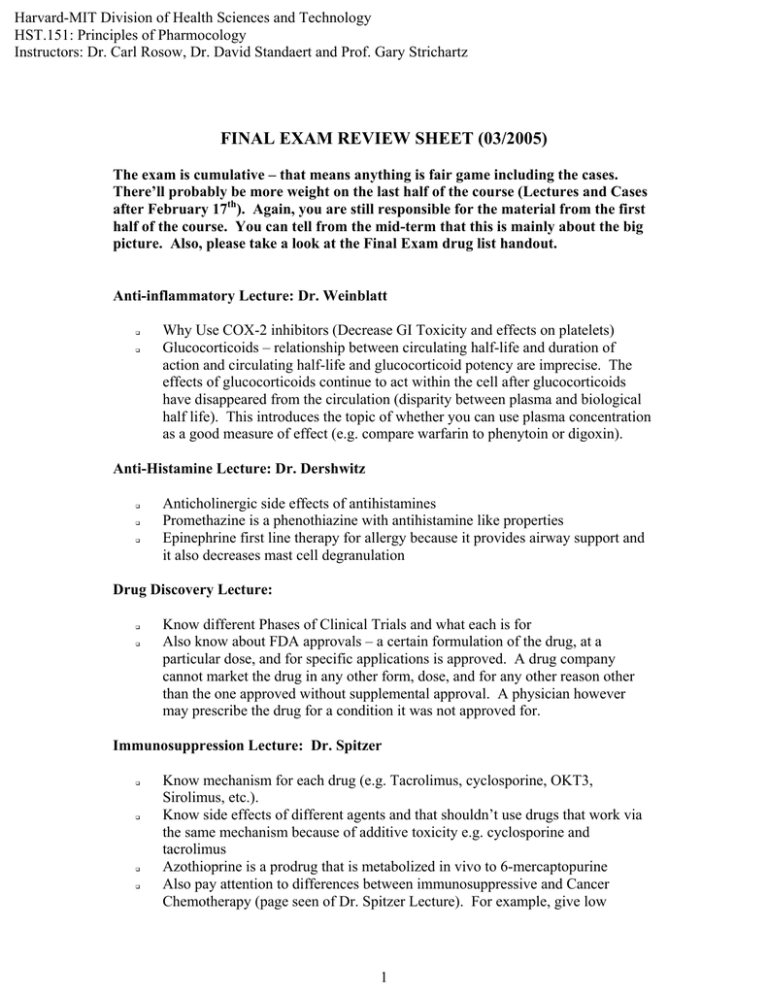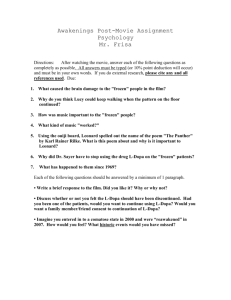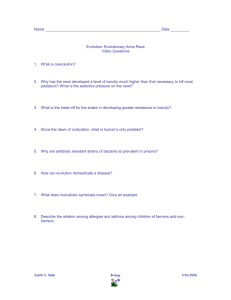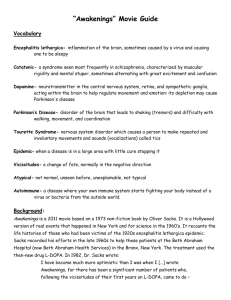Harvard-MIT Division of Health Sciences and Technology HST.151: Principles of Pharmocology
advertisement

Harvard-MIT Division of Health Sciences and Technology HST.151: Principles of Pharmocology Instructors: Dr. Carl Rosow, Dr. David Standaert and Prof. Gary Strichartz FINAL EXAM REVIEW SHEET (03/2005) The exam is cumulative – that means anything is fair game including the cases. There’ll probably be more weight on the last half of the course (Lectures and Cases after February 17th). Again, you are still responsible for the material from the first half of the course. You can tell from the mid-term that this is mainly about the big picture. Also, please take a look at the Final Exam drug list handout. Anti-inflammatory Lecture: Dr. Weinblatt Why Use COX-2 inhibitors (Decrease GI Toxicity and effects on platelets) Glucocorticoids – relationship between circulating half-life and duration of action and circulating half-life and glucocorticoid potency are imprecise. The effects of glucocorticoids continue to act within the cell after glucocorticoids have disappeared from the circulation (disparity between plasma and biological half life). This introduces the topic of whether you can use plasma concentration as a good measure of effect (e.g. compare warfarin to phenytoin or digoxin). Anti-Histamine Lecture: Dr. Dershwitz Anticholinergic side effects of antihistamines Promethazine is a phenothiazine with antihistamine like properties Epinephrine first line therapy for allergy because it provides airway support and it also decreases mast cell degranulation Drug Discovery Lecture: Know different Phases of Clinical Trials and what each is for Also know about FDA approvals – a certain formulation of the drug, at a particular dose, and for specific applications is approved. A drug company cannot market the drug in any other form, dose, and for any other reason other than the one approved without supplemental approval. A physician however may prescribe the drug for a condition it was not approved for. Immunosuppression Lecture: Dr. Spitzer Know mechanism for each drug (e.g. Tacrolimus, cyclosporine, OKT3, Sirolimus, etc.). Know side effects of different agents and that shouldn’t use drugs that work via the same mechanism because of additive toxicity e.g. cyclosporine and tacrolimus Azothioprine is a prodrug that is metabolized in vivo to 6-mercaptopurine Also pay attention to differences between immunosuppressive and Cancer Chemotherapy (page seen of Dr. Spitzer Lecture). For example, give low 1 continuous dose regimens for immunosuppression in order to maintain suppression of cellular and inflammatory responses to the persistent antigenic stimulus. Use high-dose pulse administration for cancer chemotherapy because it allows for recovery of immune function and re-growth of normal cell populations. Parkinson’s Disease and Movement Disorders: Dr. Standaert Understand combination Therapy (e.g. L-Dopa ad Carbidopa, L-Dopa with Entacapone, etc). Speaking of combination therapy, remember some of the combinations from the first half of the course (e.g. Lidocaine and epinephrine, ezetemibe and simvastatin, etc.). Understand the on/off switch: With continued use of L-Dopa patients become both tolerant and sensitized. This essentially means that there’s a narrowing of the therapeutic window and the effectiveness of L-Dopa overtime declines. Patients develop fluctuations in motor function that include periods of freezing and increased rigidity, known as “off periods”, alternating with periods of normal or even dyskinetic movement known as “on periods”. On periods usually occur initially after administration of L-Dopa and off periods as L-Dopa concentration falls. Use Combination Therapy or delay the use of L-Dopa until other medications stop working (Golan 168 – 169). This introduces the topic of how timing or the order in which we give drugs may be critical. We also saw this in the first half of the course. Remember that in treating something like pheochromocytoma that you may want to use a vasodilator such as nitroprusside before administering a B-blocker. Major limitation of long-term use is the induction of motor complications, wearing off and dyskinesia (uncontrolled rhythmic movements). Dopamine Agonists supposedly reduce incidence of wearing off and dykinesia. Side effects are the major draw back to using dopamine agonists (somnolence, hallucinations, peripheral edema) Why Use L-Dopa in the first place Dopamine Receptor Antagonists are often used as antipyschotics and some as antiemetics. Some side effects of these drugs are dystonia, tarditive dyskinesia (Mainly through blocking D2 receptors). How do you counter this? Centrally acting anticholinergics usually work well. Also risk of Neuroleptic Malignant Syndrome (Muscle rigidity, hyperthermia, increased creatinine kinase). Treat with Dontrolene to cool patients Inhaled Nitric Oxide Lecture: Dr. Zapol Why inhaled NO for ARDS? Prevent systemic side effects and able to deliver it to the functioning part of the lung Why not intravenous NO – causes systemic vasodilation and hypotension. Less Blood to the lung in already blue patient. 2 Antidepressants and Sedative Lecture: Dr. Standaert Anticholinergic side effects of TCAs Remember that clinical effects are much slower (usually weeks behind) the biochemical half life Overdose of TCAs usually lethal due to cardiac conduction disturbances. Also take care in prescribing these drugs in potentially suicidal patients. Benzodiazepines and Barbiturates – mainly used for sedation and hypnosis. Flumazenil blocks effects of benzos Barbiturates may lead to respiratory depression Redistribution is key mechanism regulating duration of the biological effect of barbiturates and benzodiazepines when administered rapidly. Can see short duration of action even though biochemical half life is longer Chronic use of sedatives (benzos or barbiturates) induces tolerance to all members of the class and cross tolerance to members of the other class Both induce tolerance to ethanol. Benzos used for alcohol withdrawal Avoid barbiturates in people with porphyries as can worsen situation due to enhanced activity of ALA synthetase which causes increased build up of neurotoxic metabolite Anticonvulsant Lecture: Dr. Stadaert Saturation kinetics for phenytoin. Also see this with Alcohol. No combination therapy because of additive toxicity and because they induce metabolism of each other and of anticoagulants. Serial administration of monotherapy better Know toxicity of different drugs What advise would you give to someone with a history of seizures who is thinking about having children Management of status epilepticus (last few pages of the lecture) AntiMicrobial Therapy Lecture: Dr. Rubin Combination Therapy To decrease resistance: Rifampin and isoniazid, etc For synergistic Effect: Ampicillin and Gentamiacin; penicillin and Blactamase inhibitor such as clavulanic acid, etc To Decrease Toxicity: Imipenam and Cilastin, etc To Increase Duration of Action: Probenecid and Penicillin, etc Remember mechanisms and modes of resistance 3 Why do some bugs develop resistance to multiple agents (MDR1 gene via plasmid) Isoniazid administered with pyridoxine because slow acetylators at risk for polyneuritis Aminoglycosides show decreased activity in low pH and oxygen tension – not recommended for abscesses. No Sulfonamides, sulfonylureas, nitrofurantoin, chloroamphenicol in patients with G6PD Deficiency – hemolysis Metronidazole and some cephalosporins give disulfuram like reaction What signs/symptoms suggest contraindication to repeated use of drug (airway and vascular) What antibiotics would you be careful with in neonates (chloramphenicol – gray baby syndrome), children (quinolones and tetacyclines – musculoskeletal side effects possible), Elderly (isoniazid – increased hepatotoxicity and aminoglycosides – increased nephrotoxicity) Remember different Dosing regimens for a reason (gentamiacin vs. cefazolin) Sulfonamides plus trimethoprim (why?) Cancer Chemotherapy Lecture: Dr. Kufe Gompertzian Growth: growth fraction is maximal at the time of initiation of growth. Generally, the smaller the size of the tumor – the higher the growth fraction and the more susceptible the tumor is to most chemotherapeutic agents. This is the rationale for debulking with adjuvant chemotherapy. Know mechanisms here (L-asparaginase, antifols, etc) Modes of Resistance to Different Drugs (methotrexate, etc) Why don’t we use sulfamethaxazole and trimthoprim for cancer chemotherapy: Toxicity is usually the limiting factor in chemotherapy. Use combination therapy to reduce toxicity. Usually go with drugs with different toxicity so that can use the full therapeutic dose without additive toxicity. Compare this to combination therapy used for hypertension. Resistance to alkylating agents plateau with time – similar to what’s seen with radiation therapy. Cancer cells develop multiple drug resistance because they lack or have defective p53, which results in impaired surveillance, and thus mutant cells avoid apoptosis. Cells with such genomic instability may become resistant. Normal cells have proper surveillance and so cells with unstable genomes usually undergo apoptosis Opioids Lecture: Dr. Rosow Opioid antagonists may be used to counter side effects be aware that they also counter the desired effect (e.g. analgesia) Eqianalgesic doses of all opioids produce equivalent amounts of respiratory depression. There is no convincing evidence that any analgesic is more or less dangerous than morphine in this regard (Dr. Rosow’s lecture) 4 One develops tolerance to the drug for respiratory depression in the same way that tolerance is developed for the analgesic effect. That said, someone who is tolerant to opioids and need huge amounts for a desired effect, is not at proportionately increased risk for respiratory depression. Patients don’t usually develop tolerance to drug for constipation and miosis. Tolerant individuals are therefore at increased risk for these side effects as you up the dose in an attempt to get the desired effect. True allergic responses to opioids are rare. Some opioids e.g. Morphine and codeine may cause displacement of histamine from tissue mast cell. This may cause hives, itching, and/or other signs similar to those seen in true allergic reactions. Note that the reaction to these drugs is not a true allergic reaction and so the drug may not be contraindicated for future use in that patient. Effects of opioid use in pregnancy – all opioids cross the placenta. Nonteratogenic effects but can cause physical dependence in utero and neonatal withdrawal after delivery can be fatal. Also, opioids given during labor can cause respiratory depression in the fetus. Know signs of physical dependence for Opioids – mydriasis, runny nose, diarrhea, shaking chills, etc. Know why use methadone to treat physical dependence to opioids Antagonists/partial agonists of opioid receptor(s) may precipitate withdrawal symptoms in patients e.g. Buprenorphine, nalorphine, nalbuphine, etc. Compare pharmacokinetics of opioids especially the three highlighted in Dr. Rosow’s lecture Interesting that morphine and meperididne are cleared mainly by hepatic metabolism yet they show increased toxicity with renal failure Compare phamacokinetics of morphine with that of fentanyl 5







